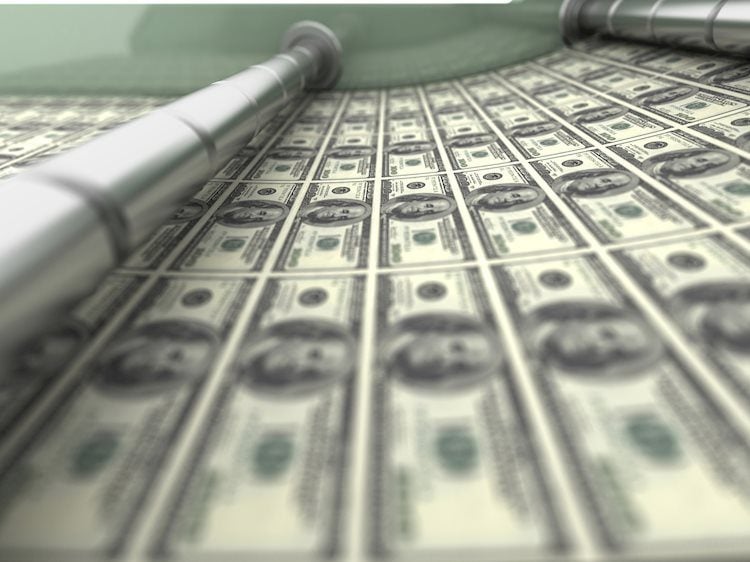In the absence of high-impact data, we will continue to focus on Fedspeak.

Here’s what you need to know for Monday, May 13th.
Financial markets were quiet to start the new week, with major currency pairs fluctuating near the previous week’s closing levels. The economic calendar will not feature any top data releases on Monday and investors will continue to closely scrutinize comments from central bank officials.
that much US Dollar (USD) The index recovered slightly on Friday after falling sharply on Thursday, helped by a hawkish stance from U.S. Federal Reserve (Fed) policymakers. By early morning in Europe on Monday, the USD index was holding steady above 105.00, while the benchmark 10-year US Treasury yield was flat near 4.5%. Meanwhile, US stock index futures rose slightly.
US Dollar PRICE Last 7 days
The table below shows the movements of the United States Dollar (USD) against major listed currencies over the last 7 days. The US dollar was the weakest against the Japanese yen.
| USD | EUR | GBP | yen | cad | AUD | new zealand dollar | Swiss Franc | |
|---|---|---|---|---|---|---|---|---|
| USD | 0.11% | -0.15% | -1.81% | -0.07% | -0.17% | -0.07% | -0.22% | |
| EUR | -0.11% | -0.17% | -1.80% | -0.11% | -0.07% | -0.10% | -0.23% | |
| GBP | 0.15% | 0.17% | -1.64% | 0.05% | 0.09% | 0.06% | -0.04% | |
| yen | 1.81% | 1.80% | 1.64% | 1.70% | 1.63% | 1.74% | 1.61% | |
| cad | 0.07% | 0.11% | -0.05% | -1.70% | -0.20% | 0.02% | -0.06% | |
| AUD | 0.17% | 0.07% | -0.09% | -1.63% | 0.20% | -0.05% | -0.10% | |
| new zealand dollar | 0.07% | 0.10% | -0.06% | -1.74% | -0.02% | 0.05% | -0.08% | |
| Swiss Franc | 0.22% | 0.23% | 0.04% | -1.61% | 0.06% | 0.10% | 0.08% |
Heatmap shows the percentage change between major currencies. The base currency is selected from the left column and the quote currency is selected from the top row. For example, if you select US Dollars in the left column and move along the horizontal line to Japanese Yen, the percentage change displayed in the box represents USD (base)/JPY (quote).
After Thursday’s surge, EUR/USD Although it pulled back on Friday, it made small gains for the week. In the early European session on Monday, the pair remained in a consolidation phase above 1.0750.
After falling below 1.2450 on Thursday to its lowest level in two weeks. GBP/USD It changed direction and ended the week above 1.2500. The pair moves up and down in a narrow band above that level to start the new week. The Office for National Statistics is due to release labor market data early Tuesday.
Australian data showed that in the Asian session, the National Australia Bank’s Business Conditions Index fell slightly from 9 in March to 7 in April, while its Business Confidence Index was unchanged at 1. AUD/USD There was no reaction to this figure and was last seen moving sideways near 0.6600. Over the weekend, China’s National Bureau of Statistics announced that the consumer price index (CPI) rose 0.3% on an annualized basis in April, exceeding market expectations and the 0.1% increase in March.
The Australian dollar is on a psychological level as we await the release of the Australian budget.
US dollar/yen It was trading slightly below 156.00 after rising nearly 2% last week. The April Producer Price Index will be included in the Japanese economic calendar during the early Asian trading hours of Tuesday’s Asian session.
gold It rose 2.5%, continuing a downward trend for two consecutive weeks. XAU/USD underwent a downward correction early Monday and is trading around $2,350.
Gold Prices Lose Traction, Pay Attention to Fedspeak.
Federal Reserve FAQs
Monetary policy in the United States is determined by the Federal Reserve (Fed). The Federal Reserve has two missions: price stability and promoting full employment. The main tool to achieve this goal is adjusting interest rates. If prices rise too quickly and inflation exceeds the Fed’s 2% target, interest rates will rise, increasing borrowing costs throughout the economy. This has made the US dollar (USD) stronger, making the country a more attractive place for international investors to put their money. When inflation falls below 2% or unemployment is too high, the Federal Reserve can lower interest rates to encourage borrowing, which weighs on the U.S. dollar.
The Federal Reserve (Fed) holds policy meetings eight times a year, and the Federal Open Market Committee (FOMC) evaluates economic conditions and makes monetary policy decisions. The FOMC is attended by 12 Federal Reserve officials, including seven board members, the president of the Federal Reserve Bank of New York and four of the remaining 11 regional reserve bank presidents. .
In extreme situations, the Federal Reserve may use a policy called quantitative easing (QE). QE is the process by which the Federal Reserve substantially increases the flow of credit in a congested financial system. It is a non-standard policy tool used in times of crisis or when the inflation rate is extremely low. This was the Fed’s weapon of choice during the 2008 financial crisis. It involves the Federal Reserve printing more dollars and using them to buy high-quality bonds from financial institutions. QE generally weakens the US dollar.
Quantitative tightening (QT) is the reverse process of quantitative tightening (QE), in which the Federal Reserve stops purchasing bonds from financial institutions and does not reinvest the principal of maturing bonds in purchasing new bonds. This is generally positive for the value of the US dollar.
Source: https://www.fxstreet.com/news/forex-today-focus-remains-on-fedspeak-in-absence-of-high-impact-data-202405130642



